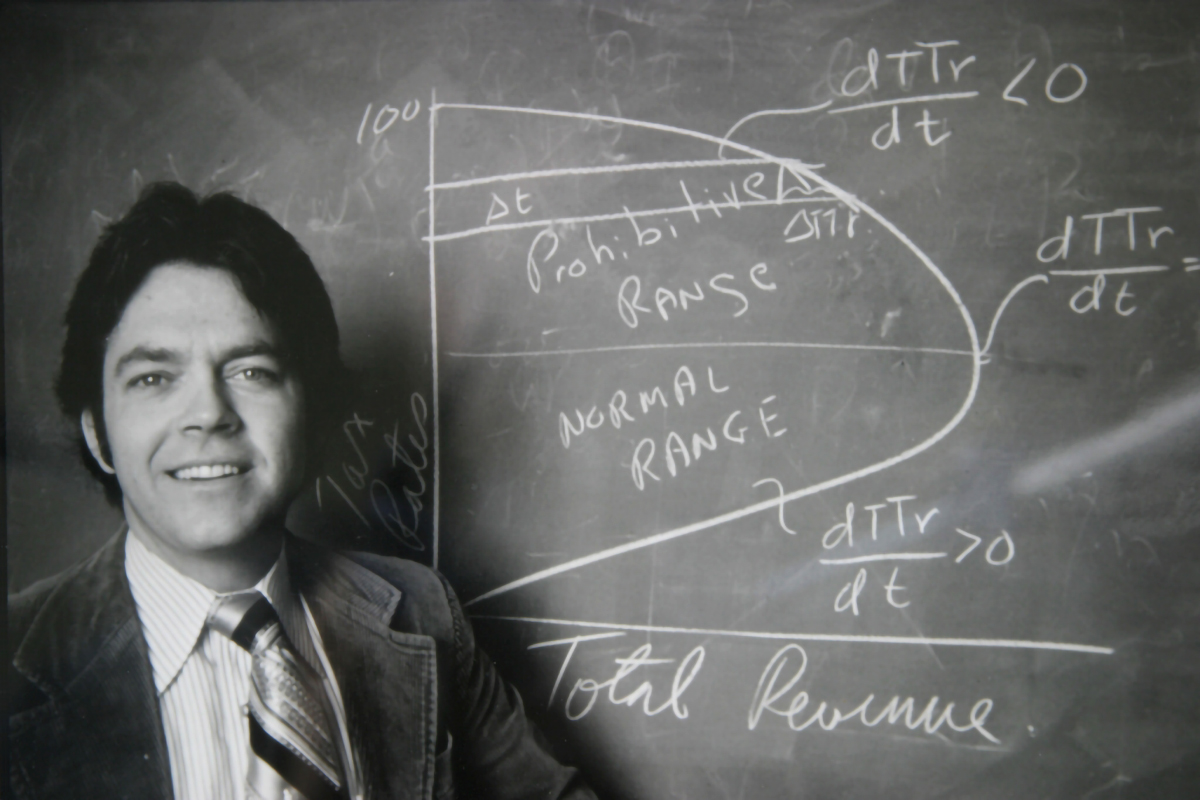Arthur B. Laffer’s economic acumen and influence in triggering a world-wide tax-cutting movement in the 1980s have earned him the distinction in many publications as “The Father of Supply-Side Economics.” The Laffer Curve is one of the main theoretical constructs of supply-side economics, illustrating the tradeoff between tax rates and actual tax revenues.

Dr. Laffer’s career has been marked by experience and success in business, in public policy, and as an academic economist and professor.
During the years 1972-1977, Dr. Laffer was a consultant to Secretaries of the Treasury George Shultz and William Simon and Chief of Staff and Secretary of Defense Donald Rumsfeld. He was the first to hold the title of Chief Economist at the Office of Management and Budget under Mr. Shultz from October 1970 to July 1972.
 Dr. Laffer was a member of President Reagan’s Economic Policy Advisory Board for both of his two terms (1981-1989). He was a member of the Executive Committee of the Reagan/Bush Finance Committee in 1984 and was a founding member of the Reagan Executive Advisory Committee for the presidential race of 1980. He also advised Prime Minister Margaret Thatcher on fiscal policy in the U.K. during the 1980s.
Dr. Laffer was a member of President Reagan’s Economic Policy Advisory Board for both of his two terms (1981-1989). He was a member of the Executive Committee of the Reagan/Bush Finance Committee in 1984 and was a founding member of the Reagan Executive Advisory Committee for the presidential race of 1980. He also advised Prime Minister Margaret Thatcher on fiscal policy in the U.K. during the 1980s.
Dr. Laffer was formerly the Distinguished University Professor at Pepperdine University and a member of the Pepperdine Board of Directors. He also held the status as the Charles B. Thornton Professor of Business Economics at the University of Southern California from 1976-1984. He was an Associate Professor of Business Economics at the University of Chicago from 1970 to 1976 and a member of the Chicago faculty from 1967-1976.
Dr. Laffer has been widely acknowledged for his economic achievements. A March 1999 Time Magazine cover story “The Century’s Greatest Minds” deemed the Laffer Curve one of “a few advances that powered this extraordinary century.” He was listed in “A Dozen Who Shaped the ‘80s” in the Los Angeles Times on January 1, 1990, and in “A Gallery of the Greatest People Who Influenced Our Daily Business” in the Wall Street Journal on June 23, 1989. His creation of the Laffer Curve was deemed a “memorable event” in financial history by the Institutional Investor in its July 1992 Silver Anniversary issue, “The Heroes, Villains, Triumphs, Failures and Other Memorable Events.”
 He has received numerous awards and recognition for his economic work, including: two Graham and Dodd Awards from the Financial Analysts Federation for outstanding feature articles published in the Financial Analysts Journal; the Distinguished Service Award by the National Association Investment Clubs; the Adam Smith Award for his insights and contributions to the Wealth of Nations; and the Daniel Webster Award for public speaking by the International Platform Association. Dr. Laffer also earned the Father of the Year award from the West Coast Father’s Day Committee in 1983.
He has received numerous awards and recognition for his economic work, including: two Graham and Dodd Awards from the Financial Analysts Federation for outstanding feature articles published in the Financial Analysts Journal; the Distinguished Service Award by the National Association Investment Clubs; the Adam Smith Award for his insights and contributions to the Wealth of Nations; and the Daniel Webster Award for public speaking by the International Platform Association. Dr. Laffer also earned the Father of the Year award from the West Coast Father’s Day Committee in 1983.
Dr. Laffer is the author of a number of books, including the End of Prosperity: How Higher Taxes Will Doom the Economy—If We Let it Happen, which was a nominee for the F.A. Hayek book award in 2009, and most recently Return to Prosperity and Trumponomics.
Dr. Laffer received a BA in economics from Yale University in 1963. He received an MBA and a PhD in economics from Stanford University in 1965 and 1972, respectively.
Dr. Laffer currently lives in Nashville, Tennessee where he is the founder and chairman of Laffer Associates, an institutional economic research and consulting firm. He was also founder and chairman of Laffer Investments, an institutional investment management firm utilizing diverse investment strategies that was a predecessor to Laffer Tengler Investments. The firms provide research and investment management services to a diverse group of clients, which includes institutions, pension funds, corporations, endowments, foundations, individuals and others.
